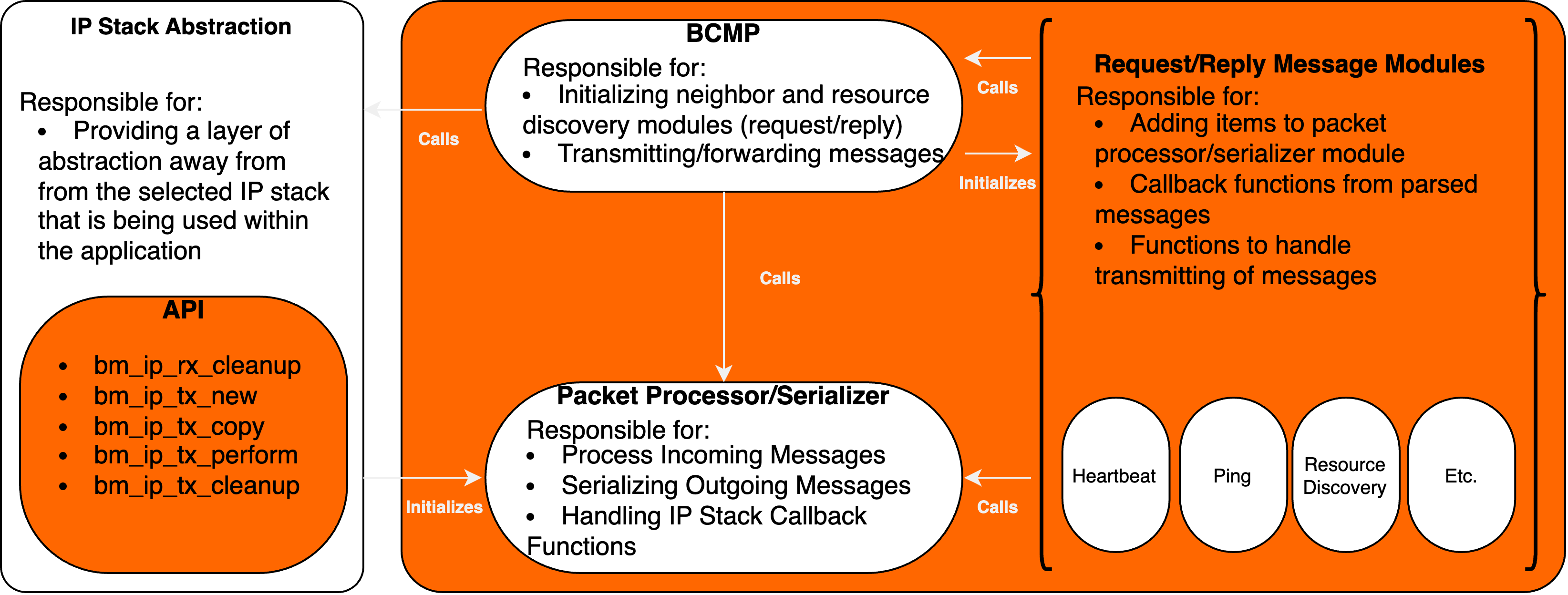BCMP
BCMP (Bristlemouth Control Messaging Protocol), which is similar to ICMP, implements neighbor and resource discovery for the Bristlemouth stack. The section of code that handles this has the following structure:

Modules
The following is an explanation of how these modules function:
BCMP
Responsible for initializing all of the BCMP message modules
Reply/Request Message Modules
Messages as defined in Network Discovery and Formation in the networking overview found in the Bristlemouth Wiki
Configures the necessary information that must be passed down to the packet module, this includes:
Size of the message type structure
If this message is a sequenced reply
If this message is a sequenced request
A callback function for incoming messages that match this message type
The available messages structures can be found under
include/messages.h
Packet Module
Used to process (incoming) and serialize (outgoing) messages
All data sent over Bristlemouth is sent in little endian format (contrary to network byte order which is big endian), this module is also responsible for ensuring the data sent and received is in the correct endianness
Outgoing messages will always be little-endian
Incoming messages will be little-endian until the process callback is handled, then the message will be in the endianness of the system
Logic that handles when messages require sequenced replies and requests
IP stack related functions are passed into the initialization of this module, they are respectively described as follows:
src_ipCallback function to obtain a pointer to the source IP address of the message
dst_ipCallback function to obtain a pointer to the destination IP address of the message
dataCallback function to obtain a pointer to the payload of the message
checksumCallback function to calculate a 16bit checksum of the message
An example of how to initialize this module utilizing LWIP:
#include "packet.h" #include "pbuf.h" #include "ip_addr.h" #include "inet_chksum.h" #include "netif.h" #include <stddef.h> typedef struct { struct pbuf *pbuf; const ip_addr *src; const ip_addr *dst; } NetworkData; static void *lwip_get_data(void *payload) { NetworkData *ret = (NetworkData *)payload; return (void *)ret->pbuf->payload; } static void *lwip_get_src_ip(void *payload) { NetworkData *ret = (NetworkData *)payload; return (void *)ret->src; } static void *lwip_get_dst_ip(void *payload) { NetworkData *ret = (NetworkData *)payload; return (void *)ret->dst; } static uint16_t lwip_get_checksum(void *payload, uint32_t size) { uint16_t ret = UINT16_MAX; NetworkData *data = (NetworkData *)payload; ret = ip6_chksum_pseudo(data->pbuf, ip_proto_bcmp, size, (ip_addr *)lwip_get_src_ip(payload), (ip_addr *)lwip_get_dst_ip(payload)); return ret; } void example_lwip_init(void) { if (packet_init(lwip_get_src_ip, lwip_get_dst_ip, lwip_get_data, lwip_get_checksum) == BmOK) { // Initialize other things maybe related to transmissions and receive handling that properly abstracts lwip // These things might pertain to how data is passed through to these other interfaces // to ensure that NetworkData is used across all transmit/receive functionality ... } }
IP Stack Abstraction
Responsible for setting up the packet module (via
packet_init, see code snippet above)For BCMP, since it is built within the network layer as akin to ICMP, the utilized API are as which must be implemented by the IP stack are as follows:
void bm_ip_rx_cleanup(void *payload)void *bm_ip_tx_new(const void *dst, uint32_t size)BmErr bm_ip_tx_copy(void *payload, const void *data, uint32_t size, uint32_t offset)BmErr bm_ip_tx_perform(void *payload, const void *dst)void bm_ip_tx_cleanup(void *payload)
Providing transmission abstract calls for allocating a new item, copying raw data to that item, performing a transmission of that item cleaning up that item
Providing receiving abstract calls for cleaning up an item after it was processed, and internally providing a callback for the IP stack
Messages
The following are a list of supported messages and what they are responsible for:
Heartbeat
Responsible for telling neighbors (devices directly connected to) that the node is active
Incoming messages are received and information is requested to know more about neighbors
Information is only requested once a new neighbor is seen (or has been re-booted)
Monitors last heartbeat a neighbor has sent
Device Information
Request device information from another node
This includes:
Node ID
Vendor ID
Product ID
Git SHA
Hardware Revision
Device Name
Firmware Version Information
Semantic Versioning
Custom String
Replying to device information requests with the above device information
This message is useful for understanding what other types of nodes are available on the network
Ping
Send a ping request to a target node id
Reply to a ping request from the targeted node id
Resource Discovery
Request a node’s current publishing and subscription topics, please see middleware for more information on this
Reply to a request with the published/subscribed topics
This can be helpful for understanding what types messages that a node might be interested in obtaining more information from
Neighbor Table
Request neighbor table information from a node
This includes each neighbors’:
Node ID
Port they are connected to
If they are online
Reply to a request for neighbor table information from a node
This is useful for applications such as discovering the topology of a whole Bristlemouth network
Please see the Neighbor Discovery section of the Networking Overview Documentation on Bristlemouth for a more in depth explanation